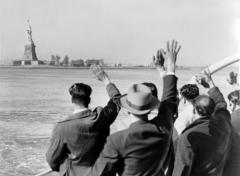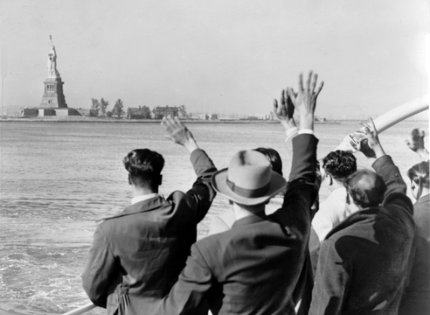
HISTORY ONLINE 24/7/365
IMMIGRATION, INDUSRIALIZATION, AND THE
PROGRESSIVE MOVEMENT
Immigration, industrialization and the Progressive Era in U. S. History 2
The late 1800’s and early 1900s saw a massive influx of immigration into the United States, as well as massive internal migration to cities, as new farm technolgies replaced farmworkers who moved to seek factory jobs in urban areas. Overcrowding and poor working conditions led to the reforms of the progressive era, creating safer working conditions, better pay, reducing child labor, and granting women the right to vote.Resources:
Immigration page at the Library of Congress Ellis Island National Museum of Immigration Take Scholastic's Virtual Tour of Ellis Island Check here to search 65 million record of immigrants coming through New York from 1820- 1957 New York's Tenement Museum Could you pass the current citizenship test? CLICK HERE! Jane Adams Nobel Prize Biography Scholastic article about Jane Adams and Hull House The Hull House Museum Biography page for William (Boss) Tweed Biography page for Booker T. Washington Biography page for W. E. B. DuBois Biography page for Ida B. Wells Progressive Era to New Era -- Library of Congress Scholastic page on the Women's Suffrage movement Women's Suffrage Movement page from the National Women's History Museum Women's Suffrage page at the History Channel Prohibition page at the History Channel Website for the Ken Burns film on Prohibition on PBS Population changes, growth of cities, and new inventions produced interaction and often conflict between different cultural groups. Social and technological changes presented challenges in urban areas Reasons for the increase in immigration • Hope for better opportunities • Desire for religious freedom • Escape from oppressive governments • Desire for adventure Reasons why cities grew and developed • Specialized industries, including steel (Pittsburgh) and meatpacking (Chicago) • Immigration to America from other countries • Movement of Americans from rural to urban areas for job opportunities Rapid industrialization and urbanization led to overcrowded immigrant neighborhoods and tenements. Efforts to solve immigration problems • Settlement houses such as Hull House, founded by Jane Addams • Political machines (e.g., Boss Tweed) that gained power by attending to the needs of new immigrants (e.g., jobs, housing) Discrimination against immigrants • Chinese • Irish • Jewish • Italian • Polish Challenges faced by cities • Tenements and ghettos • Political corruption (political machines) Discrimination against African Americans and minority groups continued after Reconstruction. “Jim Crow” laws institutionalized a system of legal segregation. African Americans differed in their responses to discrimination and “Jim Crow.” Racial segregation • Based upon race • Directed primarily against African Americans, but other groups also were kept segregated • Chinese Exclusion Act (1882) provided an absolute 10-year moratorium (halt) on Chinese labor immigration • American Indians were not considered citizens until 1924 “Jim Crow” laws • Passed to discriminate against African Americans • Made discrimination practices legal in many communities and states • Were characterized by unequal opportunities in housing, work, education, and government • Upheld by the Supreme Court in Plessy v. Ferguson African American responses • Booker T. Washington: Believed equality could be achieved through vocational education; accepted social segregation • W.E.B. DuBois: Believed in full political, civil, and social rights for African Americans and founded the National Association for the Advancement of Colored People (NAACP) along with Ida B. Wells-Barnett Between the Civil War and World War I, the United States was transformed from primarily an agricultural society into one based on manufacturing and services. Inventions had both positive and negative effects on society. Inventions that contributed to great change and industrial growth • Electric lighting and mechanical uses of electricity (Thomas Edison) • Telephone service • Railroads, which permitted large-scale, long-distance transport of goods Rise of big business led by captains of industry • Captains of industry (John D. Rockefeller, oil; Andrew Carnegie, steel; Cornelius Vanderbilt, shipping and railroads; J.P. Morgan, banking) Reasons for business growth • National markets created by transportation advances • Advertising • Lower-cost production (assembly line) • Lack of competition (monopolies and trusts) Factors that promoted industrial growth in America • Access to raw materials and energy sources • Large work force (due to immigration) • New inventions • Financial resources Examples of big business • Railroads • Oil • Steel • Coal Postwar changes in farm and city life • Mechanization (e.g., the reaper) reduced farm labor needs and increased production. • Industrial development in cities created increased labor needs. • Industrialization provided new access to consumer goods (e.g., mail order). The effects of industrialization and the Progressive Movement led to reforms. Negative effects of industrialization • Child labor • Low wages, long hours • Unsafe working conditions • Impact on the environment • Monopolies • Triangle Shirtwaist Factory fire Rise of organized labor • Formation of unions; growth of American Federation of Labor • Strikes (Homestead Strike, Pullman Strike) Progressive Movement workplace reforms • Improved safety conditions • Reduced work hours • Placed restrictions on child labor Women’s suffrage movement • Susan B. Anthony, Elizabeth Cady Stanton, Alice Paul, and Lucy Burns worked for women’s suffrage. • The movement led to increased educational opportunities for women. • Women gained the right to vote with passage of the 19th Amendment to the Constitution of the United States. Temperance movement • Composed of groups opposed to the making and consuming of alcohol • Supported legislation to ban alcohol (18th Amendment) If you do not already know your 50 states, try some of the U. S. mapping games below!U.S. Mapping Games:
Click to start here with a simple tutorial Drag and Drop by Region Drag and Drop Click on the State Drag and Drop (Harder)

ANCESTOR SEARCH !
Did your ancestors come
through New York between
1820 and 1957? Use this free
database to search immigration
records and maybe find your
ancestors!
PLAY THE CITY OF
IMMIGRANTS GAME
It’s 1907. You are Lena Brodsky,
a 14-year-old Jewish immigrant
from Russia. How will you start
a new life in America?






































HISTORY ONLINE 24/7/365
mrbower.com
IMMIGRATION, INDUSRIALIZATION,
AND THE PROGRESSIVE MOVEMENT
Immigration, industrialization and the
Progressive Era in U. S. History 2
The late 1800’s and early 1900s saw a massive influx of immigration into the United States, as well as massive internal migration to cities, as new farm technolgies replaced farmworkers who moved to seek factory jobs in urban areas. Overcrowding and poor working conditions led to the reforms of the progressive era, creating safer working conditions, better pay, reducing child labor, and granting women the right to vote.Resources:
Immigration page at the Library of Congress Ellis Island National Museum of Immigration Take Scholastic's Virtual Tour of Ellis Island Check here to search 65 million record of immigrants coming through New York from 1820-1957 New York's Tenement Museum Could you pass the current citizenship test? CLICK HERE! Jane Adams Nobel Prize Biography Scholastic article about Jane Adams and Hull House The Hull House Museum Biography page for William (Boss) Tweed Biography page for Booker T. Washington Biography page for W. E. B. DuBois Biography page for Ida B. Wells Progressive Era to New Era -- Library of Congress Scholastic page on the Women's Suffrage movement Women's Suffrage Movement page from the National Women's History Museum Women's Suffrage page at the History Channel Prohibition page at the History Channel Website for the Ken Burns film on Prohibition on PBS Population changes, growth of cities, and new inventions produced interaction and often conflict between different cultural groups. Social and technological changes presented challenges in urban areas Reasons for the increase in immigration • Hope for better opportunities • Desire for religious freedom • Escape from oppressive governments • Desire for adventure Reasons why cities grew and developed • Specialized industries, including steel (Pittsburgh) and meatpacking (Chicago) • Immigration to America from other countries • Movement of Americans from rural to urban areas for job opportunities Rapid industrialization and urbanization led to overcrowded immigrant neighborhoods and tenements. Efforts to solve immigration problems • Settlement houses such as Hull House, founded by Jane Addams • Political machines (e.g., Boss Tweed) that gained power by attending to the needs of new immigrants (e.g., jobs, housing) Discrimination against immigrants • Chinese • Irish • Jewish • Italian • Polish Challenges faced by cities • Tenements and ghettos • Political corruption (political machines) Discrimination against African Americans and minority groups continued after Reconstruction. “Jim Crow” laws institutionalized a system of legal segregation. African Americans differed in their responses to discrimination and “Jim Crow.” Racial segregation • Based upon race • Directed primarily against African Americans, but other groups also were kept segregated • Chinese Exclusion Act (1882) provided an absolute 10-year moratorium (halt) on Chinese labor immigration • American Indians were not considered citizens until 1924 “Jim Crow” laws • Passed to discriminate against African Americans • Made discrimination practices legal in many communities and states • Were characterized by unequal opportunities in housing, work, education, and government • Upheld by the Supreme Court in Plessy v. Ferguson African American responses • Booker T. Washington: Believed equality could be achieved through vocational education; accepted social segregation • W.E.B. DuBois: Believed in full political, civil, and social rights for African Americans and founded the National Association for the Advancement of Colored People (NAACP) along with Ida B. Wells-Barnett Between the Civil War and World War I, the United States was transformed from primarily an agricultural society into one based on manufacturing and services. Inventions had both positive and negative effects on society. Inventions that contributed to great change and industrial growth • Electric lighting and mechanical uses of electricity (Thomas Edison) • Telephone service • Railroads, which permitted large-scale, long- distance transport of goods Rise of big business led by captains of industry • Captains of industry (John D. Rockefeller, oil; Andrew Carnegie, steel; Cornelius Vanderbilt, shipping and railroads; J.P. Morgan, banking) Reasons for business growth • National markets created by transportation advances • Advertising • Lower-cost production (assembly line) • Lack of competition (monopolies and trusts) Factors that promoted industrial growth in America • Access to raw materials and energy sources • Large work force (due to immigration) • New inventions • Financial resources Examples of big business • Railroads • Oil • Steel • Coal Postwar changes in farm and city life • Mechanization (e.g., the reaper) reduced farm labor needs and increased production. • Industrial development in cities created increased labor needs. • Industrialization provided new access to consumer goods (e.g., mail order). The effects of industrialization and the Progressive Movement led to reforms. Negative effects of industrialization • Child labor • Low wages, long hours • Unsafe working conditions • Impact on the environment • Monopolies • Triangle Shirtwaist Factory fire Rise of organized labor • Formation of unions; growth of American Federation of Labor • Strikes (Homestead Strike, Pullman Strike) Progressive Movement workplace reforms • Improved safety conditions • Reduced work hours • Placed restrictions on child labor Women’s suffrage movement • Susan B. Anthony, Elizabeth Cady Stanton, Alice Paul, and Lucy Burns worked for women’s suffrage. • The movement led to increased educational opportunities for women. • Women gained the right to vote with passage of the 19th Amendment to the Constitution of the United States. Temperance movement • Composed of groups opposed to the making and consuming of alcohol • Supported legislation to ban alcohol (18th Amendment) If you do not already know your 50 states, try some of the U. S. mapping games below!U.S. Mapping Games:
Click to start here with a simple tutorial Drag and Drop by Region Drag and Drop Click on the State Drag and Drop (Harder)

ANCESTOR SEARCH !
Did your ancestors come through
New York between 1820 and 1957?
Use this free database to search
immigration records and maybe find
your ancestors!
PLAY THE CITY OF IMMIGRANTS GAME
It’s 1907. You are Lena Brodsky, a 14-
year-old Jewish immigrant from
Russia. How will you start a new life in
America?








































































